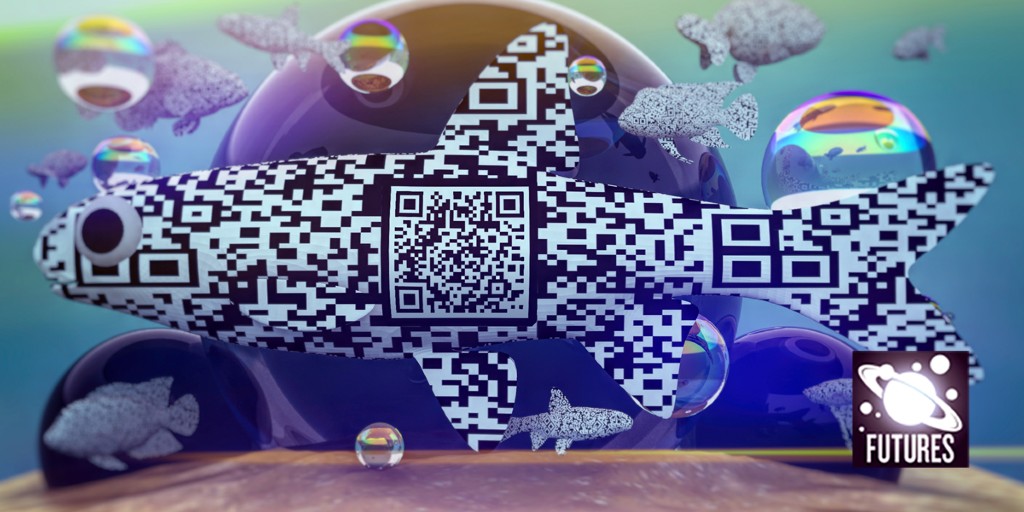It’s grossly irresponsible. Or worse. But I don’t know that yet.
Imagine a zebra, they say. What information is in its bar-coded stripes?
You can’t tell, I say; zebras don’t fit on the supermarket scanner. They call me a smart ass.
A zebra’s stripes are meaningless, I tell them. There are no data there.
What’s this about? I’ve no idea.
They try a different tack. Picture a lettuce leaf, they say, with a bar code drawn in chlorophyll, or a lemon with a scarlet bar code embedded in its peel.
I want these fools to get to the point. And now they do.
Here’s where you come in, they tell me. You’ll re-engineer plants and animals so they grow their own bar code.
I roll my eyes. Their enthusiasm is not infectious. Zebra genes contain the recipe for those stripes, right? I’m a CRISPR guy, so the role of genes is hardly news to me. Tweak those genes, et voilà: a zebra dressed in its own personal bar code.
And why would I want that? I ask. Before they can attempt an answer, I continue: Anyway, it won’t happen. Zebras don’t have a bar-code gene.
Not one, but modify enough stripy genes, and you could create a zebra that scanners will recognize. From one such experiment, anything is possible. Self-bar-coded chick peas, bananas, halibut. Think how much money our supermarkets will save.
I shake my head; it’s impossible, irresponsible and probably illegal.
They slide a piece of paper across the table. There’s a big number on it, preceded by a dollar sign.
I equivocate. Well, it might work, I tell them, but it’d take decades of research. And it’s utterly irresponsible.
They slide across another piece of paper. With an extra zero.
I clarify my previous statement. I have been too hasty. Give me a year.
Early next morning, I’m in the lab.
Zebras are unpredictable, rare in California, and they bite. So I stock six aquaria with zebrafish.
Like their hoofed namesakes, zebrafish have stripe-defining genes; it’s just a matter of figuring out where they are. I throw CRISPR at them, zinc fingers and more. Over the next few months, I create fish with smudges and blotches, fish with swirls, chess-board fish, fractal fish, kaleidoscopic fish. Then, a few 11-week generations down the line, bar-coded fish.
I report back, bringing samples for a show-and-tell session. The theory is fine, I say. However, although the code is frequently right, it’s often wrong. The fish in this tank are OK — I hold up an example by the fin — but most fish in the tank over there carry the code for a plastic light socket, and a few think they are Tesla Roadsters. No supermarket would go for it.
Have you tried QR codes instead, one of them says. I raise my eyebrows in surprise. There’s spare room in a QR code, she continues, so a few blobs out of place won’t matter. Put a bar code into the QR multiple times; the scanner can choose the most common one, ignoring any mistakes.
Get real, I say, bar codes were difficult enough; this is impossible.
They pass across a piece of paper with a further zero. This appears to be important new data. Relevant to the project. In fact, extremely relevant. What seemed impossible moments ago might be possible after all. I return to the lab.
Soon I have QR-coded fish. But producing QR codes one foodstuff at a time will take forever, so I must become more adventurous.
I build a virus to insert QR code instructions into the DNA of any food. It works perfectly for lettuce leaves, chickens (once plucked), blueberries and every other edible that gets the virus. My postdoc facetiously suggests I should make a QR code for milk. I fire him.
My wife is delighted by my rediscovered passion for life, and is soon pregnant with our first child. My personal and academic happiness is unbounded, just like my bank balance. Life couldn’t be better.
I meet my sponsors once more, bringing gifts of bar-coded Chinese leaves, parsnips and bison. They are thrilled.
A guy I’ve not seen before accompanies them. His face is vaguely familiar; something in security, I seem to recall. He asks for details of my work. I’m wary, but when he moots an all-expenses-paid trip to Hawaii to discuss my research, slots in my calendar magically open up. I feel bad deserting my wife days before the baby is due, but my absence will be brief.
On our fourth day at the beach, my wife goes into labour, so I rush back to California for the birth.
Our child is perfect.
Apart from the nine QR codes decorating his bottom.
I surreptitiously scan them while the nurse is out of the room. Most are random, but one codes for a Tesla Model X and another for lamb biryani.
My wife has spotted the unusual birth marks, but I assure her that anyone who is anyone these days has a tattoo.
Within hours, an e-mail arrives from Hawaii, asking how the birth went. I am shocked to discover that my acquaintance’s e-mail address is …@cia.gov.
Giddy with panic, I rush to the lab. I destroy my equipment, my chemicals, the fish, my notes and my computer.
But I know it’s too late. The genie is out of the bottle.







More News
India’s 50-year-old Chipko movement is a model for environmental activism
AI & robotics briefing: Winged robot demystifies insect flight
Charles Darwin investigates: the curious case of primrose punishment